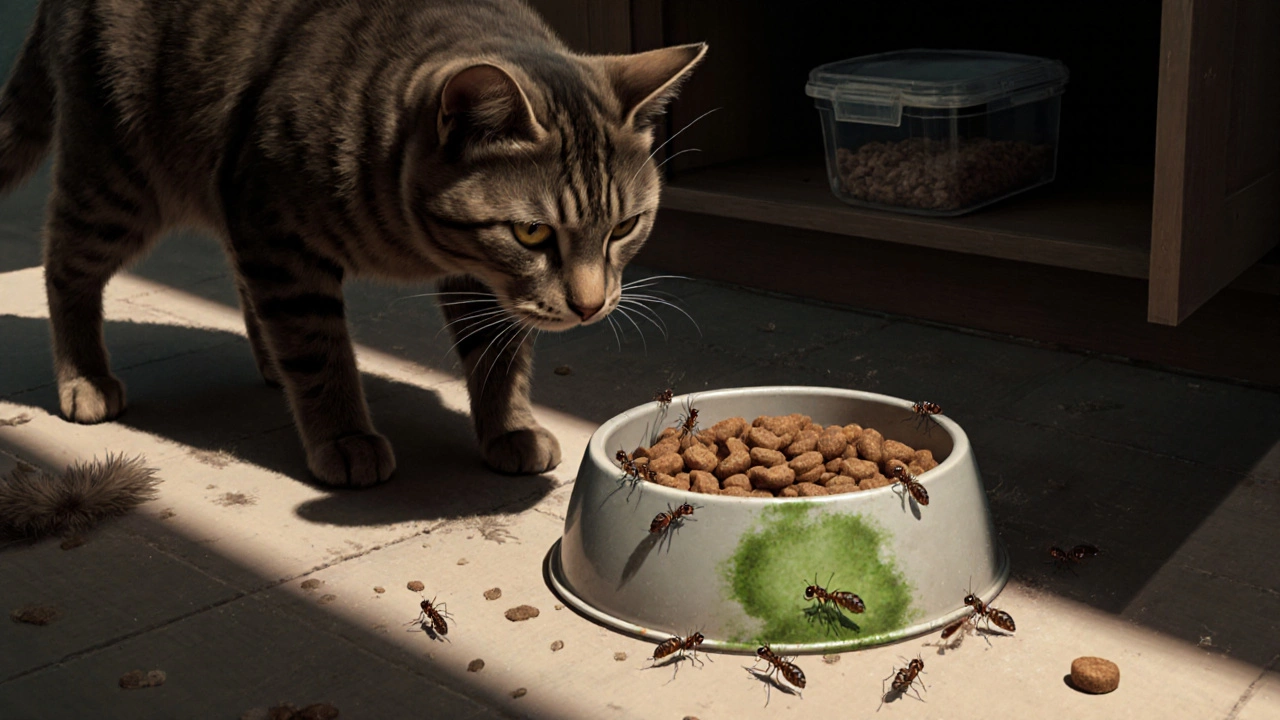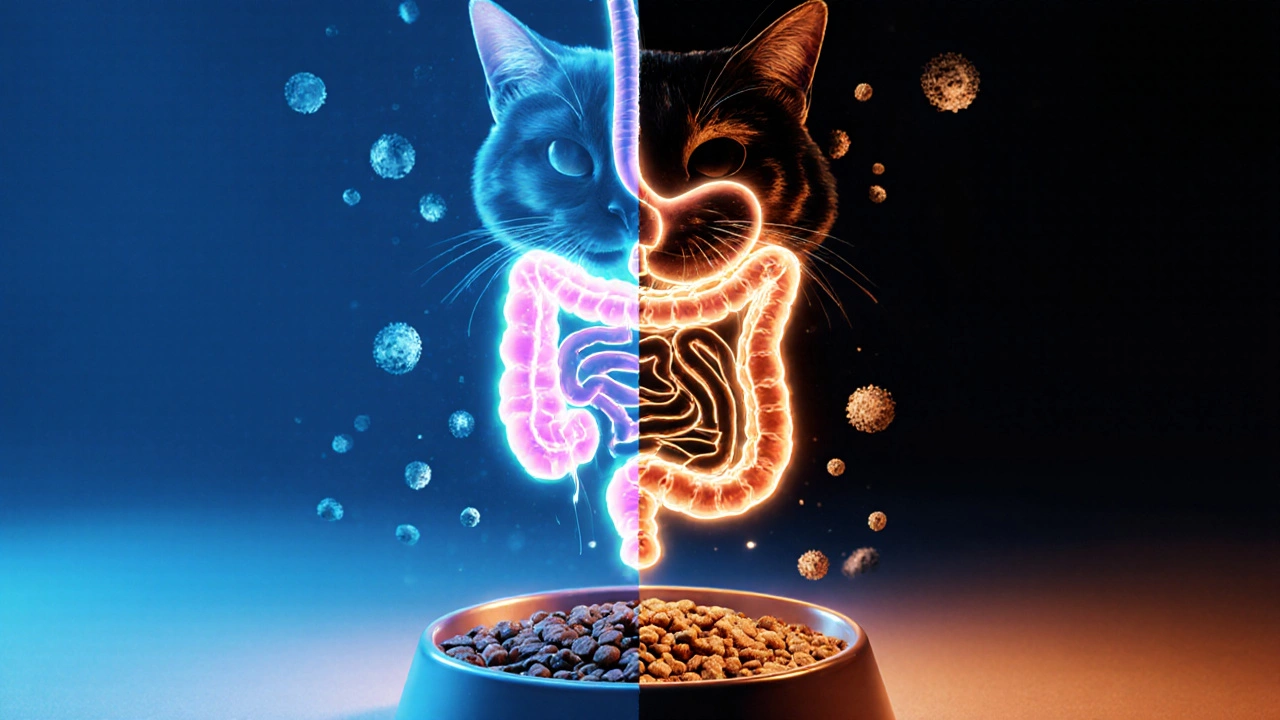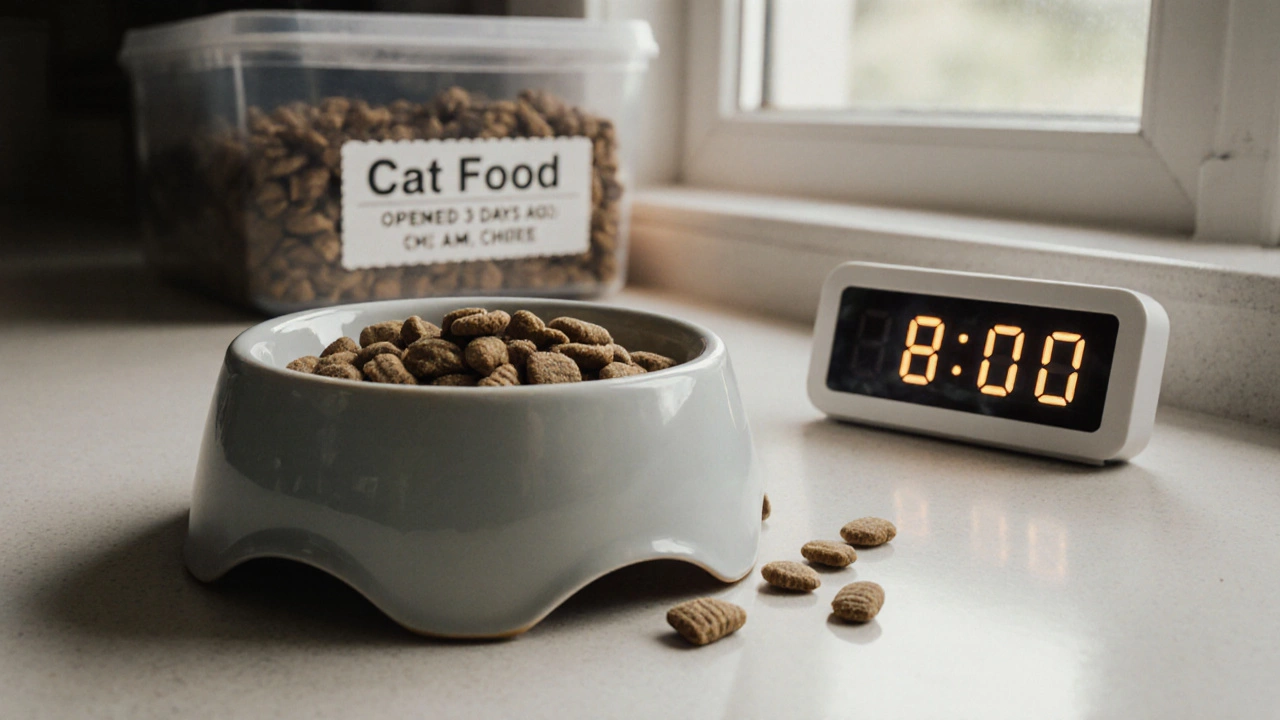Dry Cat Food Freshness Calculator
How Long Does Your Cat's Food Stay Fresh?
Based on veterinary guidelines, dry cat food can become stale or spoiled in as little as 4-6 hours under certain conditions. Calculate your food's freshness duration based on environmental factors.
Freshness Duration:
Based on your inputs, this is how long your dry cat food will stay fresh under these conditions.
Recommendation:
Leaving dry cat food out all day seems like the easiest way to feed your cat-especially if you’re gone for hours or work long shifts. But is it really safe? Or are you risking your cat’s health without even knowing it?
Many cat owners assume that because dry food doesn’t spoil like wet food, it’s fine to leave it out. But that’s a myth. Dry cat food can go bad faster than you think, and leaving it out all day can attract pests, lose nutrients, and even make your cat sick.
How Long Can Dry Cat Food Stay Out?
Dry cat food doesn’t rot like meat, but it doesn’t last forever either. Once opened, it starts losing freshness within 24 hours. The oils in the kibble begin to oxidize, which makes them rancid. Rancid fat doesn’t just taste bad-it can upset your cat’s stomach and reduce the nutritional value of the food.
According to the Association of American Feed Control Officials (AAFCO) a nonprofit organization that sets nutritional standards for pet food in the U.S., dry pet food should be consumed within 4-6 weeks after opening. But that’s only if stored properly-in an airtight container, in a cool, dry place. Leaving it in an open bowl on the counter? That’s a different story.
Heat, humidity, and air exposure speed up spoilage. In a warm kitchen or near a window, dry food can become stale or moldy in as little as 4-6 hours. Mold spores grow fast in moist environments, and even a tiny bit of mold can cause vomiting, diarrhea, or worse in cats.
What Happens When You Leave Dry Cat Food Out All Day?
Here’s what actually happens when you leave dry food out for 12, 18, or 24 hours:
- It gets stale. The crunch goes away. Cats are picky eaters. If the kibble loses its texture, they’ll stop eating it-even if they’re hungry.
- Pests show up. Ants, cockroaches, and even mice are drawn to dry cat food. One study from the University of California, Davis a leading veterinary and animal science research institution. found that 37% of households leaving dry food out overnight had visible insect activity near the bowl.
- It collects dust and hair. Your cat walks through the food, sheds fur, and kicks litter dust into the bowl. That’s not just gross-it’s a health risk.
- Nutrients degrade. Vitamins like B1 (thiamine) and E break down quickly when exposed to air and light. Over time, your cat isn’t getting the full nutrition the label promises.
- It encourages overeating. Free-feeding leads to weight gain. A 2023 survey of 2,000 cat owners by the American Association of Feline Practitioners a professional group of veterinarians specializing in cat care. found that cats fed free-choice were 2.3 times more likely to be overweight than those on scheduled meals.
Why Cats Prefer Scheduled Feeding
Contrary to popular belief, cats don’t naturally graze all day. In the wild, they hunt small prey 10-20 times a day-but they eat quickly and then rest. Their bodies are built for intermittent meals, not constant snacking.
When you leave food out all day, you’re fighting their biology. Cats don’t have a strong hunger signal like dogs. They’ll eat because it’s there, not because they’re hungry. That’s why so many indoor cats become obese.
Feeding your cat two to three measured meals a day helps regulate their appetite, keeps their metabolism steady, and makes it easier to notice if they stop eating-which is often the first sign of illness.

What’s the Best Way to Feed Dry Cat Food?
You don’t have to switch to wet food to do this right. Here’s how to feed dry food safely and effectively:
- Measure portions. Use a measuring cup. Don’t guess. Most adult cats need 1/4 to 1/2 cup per day, split into meals. Check the bag for feeding guidelines based on weight.
- Feed twice a day. Morning and evening works best. It mimics their natural hunting rhythm.
- Use an airtight container. Store leftover food in a sealed plastic or metal bin. Glass jars work too. Avoid the original bag-it doesn’t seal well.
- Wash the bowl daily. Bacteria build up fast in food bowls. Use warm, soapy water. Don’t just rinse.
- Replace food every 8-12 hours. If you leave it out, take it away after 12 hours-even if your cat didn’t finish it. Don’t mix old and new food.
When Is Free-Feeding Okay?
There are a few exceptions. Some cats thrive on free-feeding:
- Kittens under 6 months. They need frequent meals and small portions. You can leave food out, but monitor intake closely.
- Underweight or high-energy cats. If your vet recommends extra calories and your cat won’t eat on schedule, free-feeding might be a short-term solution.
- Multi-cat households with food-motivated cats. If one cat hoards food and others are shy, free-feeding can cause stress. Use automatic feeders or separate feeding zones instead.
Even then, don’t leave food out 24/7. Use timed feeders that dispense meals at set hours. That way, you control portions and freshness.
Signs Your Cat’s Food Has Gone Bad
Watch for these red flags:
- A sour or rancid smell (like old oil or crayons)
- Clumping or stickiness in the kibble
- Mold spots (fuzzy green or white patches)
- Your cat walks away from the bowl or eats slowly
- Increased vomiting or diarrhea after meals
If you see any of these, throw the food out. Don’t try to salvage it. Your cat’s gut is sensitive. It’s not worth the risk.

Alternatives to Leaving Food Out
If you’re away for long hours, here are better options:
- Automatic feeders. These dispense food at set times. Some even have cameras and voice recorders. Look for models with sealed food bins and battery backup.
- Slow-feed bowls. These make cats work for their food, slowing down eating and reducing overconsumption.
- Wet food for one meal. Mix one can of wet food into your cat’s daily ration. It adds moisture and keeps them satisfied longer.
Even if you stick with dry food, scheduling meals is better for your cat’s health, your wallet, and your peace of mind.
Final Verdict: Don’t Leave Dry Cat Food Out All Day
Leaving dry cat food out all day might seem convenient, but it’s not safe, not healthy, and not necessary. Your cat doesn’t need constant access to food-they need consistent, fresh meals.
By switching to scheduled feeding, you’re not just preventing spoilage. You’re helping your cat maintain a healthy weight, catch early signs of illness, and enjoy food that actually tastes good.
Start today. Measure the food. Wash the bowl. Set a timer. Your cat will thank you-with better energy, shinier fur, and fewer vet visits.
Can dry cat food go bad if left out overnight?
Yes. Dry cat food can become stale, rancid, or moldy within 12-24 hours, especially in warm or humid conditions. Even if it looks fine, the fats break down and lose nutritional value. Always discard food left out longer than 12 hours.
Is it okay to leave dry cat food out for 24 hours?
No. Leaving dry food out for 24 hours increases the risk of contamination from pests, dust, and bacteria. It also encourages overeating and weight gain. Most veterinarians recommend removing uneaten food after 8-12 hours.
Why does my cat only eat when I’m home?
Cats are sensitive to routine and environment. If they’re used to being fed when you’re around, they may associate mealtime with your presence. They might also feel safer eating when they think you’re watching. Try using an automatic feeder to build a consistent schedule.
How do I know if my cat’s dry food is still fresh?
Check the smell-fresh food has a mild, meaty odor. Rancid food smells oily, sour, or like old crayons. Look for clumping, discoloration, or mold. If your cat suddenly refuses to eat it, the food may have gone bad.
Can I mix wet and dry food to reduce waste?
Yes. Mixing one meal of wet food with dry food helps keep your cat hydrated and satisfied. Wet food spoils faster, so only leave it out for 30-60 minutes. Use dry food for scheduled meals and wet food as a treat or supplement.
Next Steps for Cat Owners
Start small. Pick one change:
- Measure your cat’s daily food today.
- Buy an airtight container for storage.
- Set two daily feeding times on your phone.
- Wash the food bowl tonight.
Within a week, you’ll notice your cat eating more eagerly, and you’ll feel more confident about their health. This isn’t about perfection-it’s about better habits. And for your cat, that makes all the difference.
